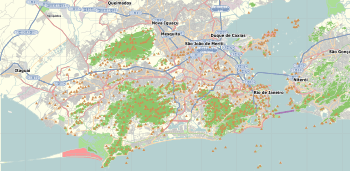Jacarepaguá Airport
Jacarepaguá–Roberto Marinho Airport (IATA: RRJ, ICAO: SBJR) is an airport in the neighborhood of Barra da Tijuca, Rio de Janeiro, Brazil dedicated to general aviation. Following extensive renovation in 2008 the airport was renamed after Roberto Pisani Marinho (1904–2003), a journalist and former president of Globo Network.[4] It is a major helibase for offshore support.
Jacarepaguá–Roberto Marinho Airport Aeroporto de Jacarepaguá–Roberto Marinho | |||||||||||
|---|---|---|---|---|---|---|---|---|---|---|---|
 | |||||||||||
| Summary | |||||||||||
| Airport type | Public | ||||||||||
| Operator | Infraero | ||||||||||
| Serves | Rio de Janeiro | ||||||||||
| Elevation AMSL | 3 m / 9 ft | ||||||||||
| Coordinates | 22°59′15″S 043°22′12″W | ||||||||||
| Website | www4 | ||||||||||
| Map | |||||||||||
 RRJ Location within greater Rio de Janeiro | |||||||||||
| Runways | |||||||||||
| |||||||||||
| Statistics (2019) | |||||||||||
| |||||||||||
It is operated by Infraero.
History
On November 14, 1927 the Compagnie Générale Aéropostale started its operations in Brazil flying between Natal and Buenos Aires, with multiple stops on the Brazilian coast, using aircraft with landing gear having as pilots Jean Mermoz, Antoine de Saint-Exupéry, and Henri Guillaumet among others. It was part of a larger project linking France and South America. The airline was based in Rio de Janeiro, from where flights departed north and southbound. In Rio de Janeiro it used not only the military airport Campo dos Afonsos but it also had its own alternative airport, called Latecoère Field. This private facility became later known as Jacarepaguá Airport. Even though Campo dos Afonsos had a better structure and easier access, the air approach was difficult and the weather was not always good. With the dissolution of Aéropostale in 1932 and the airport was forgotten.[5]
In 1944, the airport became a base of the Brazilian Air Force and it was used for flight training. On September 19, 1966 it was decommissioned and it became an airfield for general aviation.
It was only in 1969 that the construction of a terminal, an apron and hangars began. On January 19, 1971 the new airport was officially opened.
The main user was Aeroclube do Brasil (English: Brazil Flying club). It operated previously at Manguinhos Airport but with the closure of that facility in 1961 it spent years without being able to operate. In 1971 it moved its headquarters to Jacarepaguá Airport where hangars and administrative and social center were built and it was able to operate once again.
During the year 2007 Jacarepaguá Airport underwent major renovations as preparations for the 2007 Pan American Games. The runway was extended, the terminal was renovated, the control-tower got new equipment and the apron and runway got new lightning systems. Later, Infraero considered the airport in condition to handle the increase of traffic during the 2014 FIFA World Cup and the 2016 Summer Olympics.[6]
Currently most of the operations at the airport are by helicopter and aircraft operators offshore oilfields. However, on September 11, 2019 it was announced that TwoFlex was granted rights to operate a regular flight to São Paulo–Congonhas Airport. Those flights operated between October 28, 2019[7] and March 13, 2020.
Airlines and destinations
No scheduled flights operate at this airport.
Accidents and incidents
- 17 May 1975: a Douglas C-47B PP-CDD of Motortec Indústria Aeronáutica was reported to have been damaged beyond economic repair at Jacarepaguá Airport.[8]
- 16 September 2005: a private Cessna 525 Citation Jet registration PT-WLX on a ferry flight between Rio de Janeiro-Santos Dumont and Jacarepaguá airports crashed on Morro da Taquara, near the neighborhood of Barra da Tijuca. Its 2 occupants died.[9]
Access
The airport is located in the neighborhood of Barra da Tijuca 34 km (21 mi) from downtown Rio de Janeiro.
See also
References
- "Estatísticas". Infraero (in Portuguese). 20 February 2020. Retrieved 13 June 2020.
- "Aeroporto do Rio de Janeiro - Jacarepaguá". Infraero (in Portuguese). Retrieved 13 June 2020.
- "Aeródromos". ANAC (in Portuguese). 15 October 2019. Retrieved 13 June 2020.
- "Lei n˚11.702, de 18 de junho de 2008" (in Portuguese). Lei Direto. June 19, 2008. Archived from the original on October 8, 2011. Retrieved May 10, 2011.
- Pereira, Aldo (1987). Breve história da aviação comercial brasileira (in Portuguese). Rio de Janeiro: Europa Empresa Gráfica e Editora. pp. 27, 28.
- "Infraero vai gastar R$5 bi em reforma de aeroportos". Valor Econômico. August 31, 2009. Retrieved October 9, 2009.
- "TwoFlex cria voo de Jacarepaguá (RJ) para Congonhas (SP)". Aeropflap (in Portuguese). 11 September 2019. Retrieved 11 September 2019.
- "Accident description PP-CDD". Aviation Safety Network. Retrieved August 21, 2010.
- "Accident description PT-WLX". Aviation Safety Network. Retrieved July 26, 2011.
External links
| Wikimedia Commons has media related to Aeroporto de Jacarepaguá. |
- Airport information for SBJR at World Aero Data. Data current as of October 2006.Source: DAFIF.
- Airport information for SBJR at Great Circle Mapper. Source: DAFIF (effective October 2006).
- Current weather for SBJR at NOAA/NWS
- Accident history for SBJR at Aviation Safety Network